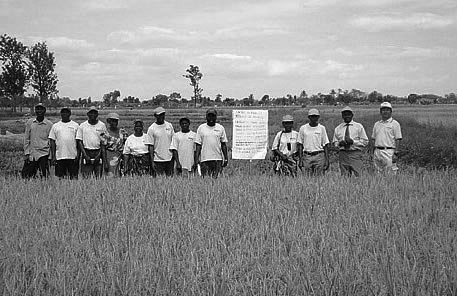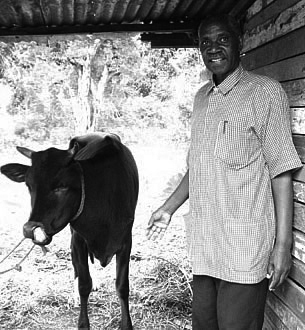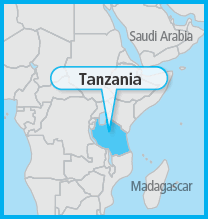Japan's Official Development Assistance White Paper 2009
Column 11 "Japan" Popular in Tanzania
— Supporting the Spread of Rice Cultivation from the Foot of Kilimanjaro —
In a market of Moshi, a town in northern Tanzania at the foot of Kilimanjaro, a rice by the name of "Japani" (the Swahili word for "Japan") is being sold. Japan has greatly contributed to the commercialization of this rice which is popular among the people of Tanzania.
Japan has provided cooperation for irrigated rice cultivation in the Kilimanjaro Region since the 1970s. At the Lower-Moshi irrigation district (paddy area of 1,100 ha), which was completed in 1987, the yield of unhulled rice was boosted from approximately two tons to six tons per hectare. Since the mid-1990s, with the Kilimanjaro Agricultural Training Centre (KATC) as a base, approximately 2,000 agriculture promoters and major farmers in Tanzania and neighboring countries have been given instruction on basic irrigated rice cultivation techniques, including dike building, paddy leveling, rice planting, early weeding, and water management. Since 2007, Japan has cooperated for "Supporting Systems for spread of Irrigated Agriculture in Tanzania project" (referred to as "Tan-Rice") with KATC and three other domestic agricultural research institutes and rice research programs.
During the first year of a Tan-Rice project cycle, methods for spreading irrigated rice cultivation techniques are taught to workers at agricultural research institutes and major farmers in central, western, and southern Tanzania. In the second year, instruction is given on ways to improve the lives of farmers, including the perspective of gender equality, methods for managing organizations to maintaining irrigation facilities, and rice cultivation techniques at paddies. This cooperation is scheduled to be carried out at 40 irrigation districts through 2012.
Mr. Motonori Tomitaka, an expert who is working for the Tan-Rice project, has been dispatched to Tanzania twice before, from 1986 to 1991 and from 1994 to 1999. In 1987, Mr. Muramba, a local farmer, provided a paddy for demonstrating rice cultivation during the dry season, and received instruction from Mr. Tomitaka together with other people in the village. Subsequently, in this village and at nearby farmlands with a good flow of water, rice came to be cultivated twice a year. Mr. Muramba bought a cow with the money that he earned from selling the rice produced during the dry season for the first time. He treasures a photograph of that cow with his training materials. When Mr. Tomitaka returned to the village of Musa Mwijanga in the Kilimanjaro Region in 2008, he met with Mr. Muramba again for the first time in 10 years. Mr. Muramba said, "I do not have that cow anymore, but I named its grandchild 'Kumbuka Japani (Memory of Japan in Swahili),'" and Mr. Tomitaka nostalgically remembered the days he began instruction on rice cultivation.
Mr. Tomitaka says, "I sometimes go to the market in Moshi, and whenever I see Japani rice there, I find that rice cultivation in Tanzania is gradually developing despite facing many challenges and problems." The Tan-Rice project is also supporting rice research programs in order to give shape to possibilities for new varieties of rice, including NERICA*1. The results of such support for rice cultivation in Tanzania are expected to greatly contribute to efforts to double rice production in sub-Saharan Africa over the next 10 years, which Japan announced at the Fourth Tokyo International Conference on African Development (TICAD IV) in May 2008.
*1 New Rice for Africa (NERICA) (Rice that is a hybrid of Asian rice, which gives a large yield, and African rice, which is strong against diseases).

Mr. Tomitaka (far left) at a training farm. (Photo: Mr. Tomitaka)

Kumbuka Japani and Mr. Muramba. (Photo: Mr. Tomitaka)

